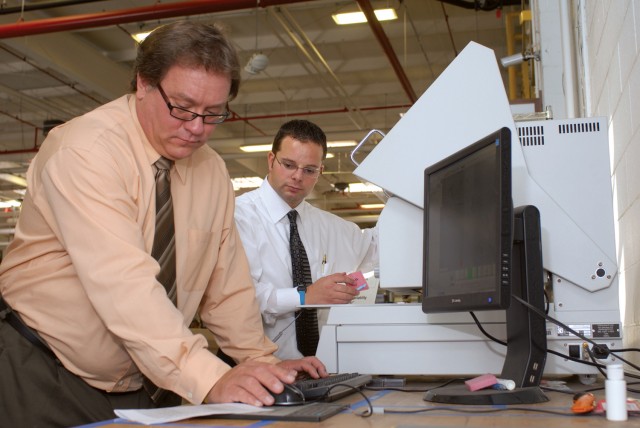TOBYHANNA ARMY DEPOT, Pa. - An X-ray Fluorescence spectrometer will help make electronic systems repaired at the depot.
The X-ray Fluorescence (XRF) spectrometer is used to measure the amount of tin (Sn) and lead (Pb) present in a component lead. A component lead is an extension of a component that is made of a metal alloy, and provides a place to solder/connect the component to a circuit card.
Although many electronic manufactures have switched to lead-free processing, lead ensures a high reliability of components in electronic systems. An acceptable measure in components is more than 3 percent lead.
Tin whiskers occur if there is over 97 percent tin present in a component, including transistors, resistors, capacitors, microcircuits and diodes. These whiskers are tiny, electrically conductive crystalline structures of tin that sometimes grow from surfaces where tin is used as a finish. These tin outcroppings, which are often caused by things such as surface oxidation, co-deposited hydrogen and intermetallic formation, can grow to several millimeters in length.
When whiskers get too close to another component they can short out electronics and cause failures in electronic systems, such as missiles and satellites.
Because of this potential hazard, employees in the Productivity Improvement and Innovation (PII) Directorate have integrated an XRF Spectrometer into the receiving process here.
The $80,000 Spectrometer is used to identify elements in a substance by measuring the wavelength of the X-ray emission or energy. The machine measures the amount of elements present in a substance by measuring the intensity of the emission. It\'s also used to measure the composition of the moon's surface, for soil surveys, and environmental studies.
"We're trying to protect the customer by screening all electronic components that arrive at the depot," said Ray Rowe, an electronics engineer in the directorate's Process Engineering Division.
The depot acquired the XRF after a successful demonstration project earlier this year.
"We wanted to incorporate the XRF into our process because when you work on systems that people are flying, you want to ensure that you're using high-quality components," Rowe said.
When components are received at the depot, they are automatically sent to the station where the machine is located, Building 1C, Bay 6. Scott Hansen operates the machine and gathers data. He is an electronics worker in the Command, Control and Computers (C3)/Avionics Directorate's Avionics Division, on a temporary assignment in PII.
The spectrometer is calibrated each morning before use. The components are placed on a flat surface inside the machine and the image is magnified on a computer screen. Next, Hansen pinpoints a spot on the component lead and the machine scans the surface. The computer compiles information about the different compositions in the metal and stores it in a database. If it scans a piece that is less than three percent lead, it is highlighted in red.
For large quantities of components, Hansen uses a military specification sample size chart to determine how many he needs to scan. He randomly picks the amount and scans them at one time. He explains that the machine stores the target locations, "so you can pretty much point where to scan on each one and walk away while it scans them."
Hansen marks the components that passed the scan with a green star and he puts a red star on components that do not meet specifications.
The pieces marked with a red star are sent to support shops in the C3/Avionics, Communication Systems and Intelligence, Surveillance and Reconnaissance (ISR) directorates. Technicians in the shops follow a document, titled "Recoat Procedure for High Tin Content Electronic Components." The document explains and how to recoat the leads to eliminate/reduce growth of tin whiskers.
Hansen produces weekly reports by using data outputs from the database scans. The reports include information such as how many components passed, failed and the total scanned. "I track the information to see how large of an issue it is and how consistent the information is, week to week," he explained.
Rowe foresees the machine as a useful tool for other areas in the depot. Hansen assisted an employee in the Systems Integration and Support Directorate's Electronic Services Division with an issue he had with bolts that were continuously snapping when they were being twisted into place. "We scanned a bolt with the XRF and found out that they contained a high amount of tin and aluminum, and not enough iron," Hansen explained.
There are three machines on order for the Quality Improvement Division, and the ISR, and C3/Avionics directorates.
Rowe and Hansen agree that they were unaware the lead-free components into the depot was such a large issue. Personnel from Letterkenny Army Depot visited the depot while researching the spectrometer, hoping to acquire one at their facility.
Rowe says they have received positive feedback from employees because they have seen the machine avoid a potential issue. "I believe we're paving the way with this technology. We've identified issues and we're doing our best to correct them," he added.
Tobyhanna Army Depot is the largest full-service Command, Control, Communications, Computers, Intelligence, Surveillance, and Reconnaissance (C4ISR) maintenance and logistics support facility in the Department of Defense. Employees repair, overhaul and fabricate electronics systems and components, from tactical field radios to the ground terminals for the defense satellite communications network.
Tobyhanna's missions support all branches of the Armed Forces. The depot is the Army Center of Industrial and Technical Excellence (CITE) for Communications-Electronics, Avionics, and Missile Guidance and Control Systems and the Air Force Technology Repair Center (TRC) for ground communications and electronics.
About 5,700 personnel are employed at Tobyhanna, which is located in the Pocono Mountains of northeastern Pennsylvania.
Tobyhanna Army Depot is part of the U.S. Army CECOM Life Cycle Management Command. Headquartered at Fort Monmouth, N.J., the command's mission is to research, develop, acquire, field and sustain communications, command, control, computer, intelligence, electronic warfare and sensors capabilities for the Armed Forces.


Social Sharing